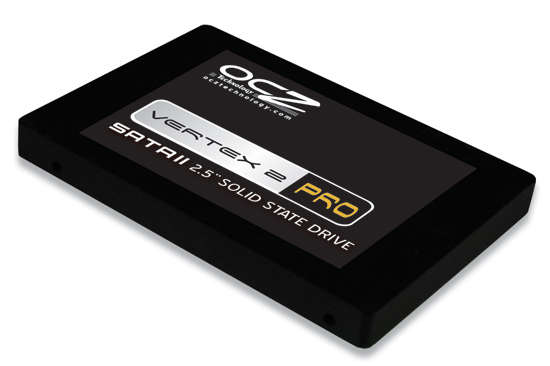OCZ's Vertex 2 Pro Preview: The Fastest MLC SSD We've Ever Tested
by Anand Lal Shimpi on December 31, 2009 12:00 AM EST- Posted in
- Storage
One thing AMD has taught me is that you can never beat Intel at its own game. Simply trying to do what Intel does will leave you confined to whatever low margin market Intel deems too unattractive to pursue. It’s exactly why AMD’s most successful CPU architectures are those that implement features that Intel doesn’t have today, but perhaps will have in a few years. Competing isn’t enough, you must innovate. Trying to approach the same problem in the same way but somehow do it better doesn’t work well when your competition makes $9B a quarter.
We saw this in the SSD space as well. In the year since Intel’s X25-M arrived, the best we’ve seen is a controller that can sort-of do what Intel’s can just at a cheaper price. Even then, the cost savings aren’t that great because Intel gets great NAND pricing. We need companies like Indilinx to put cost pressure on Intel, but we also need the equivalent of an AMD. A company that can put technological pressure on Intel.

That company, at least today, is SandForce. And its disciple? OCZ. Yep, they’re back.
Why I Hate New SSDs
I’ll admit, I haven’t really been looking forward to this day. Around the time when OCZ and Indilinx finally got their controller and firmware to acceptable levels, OCZ CMO Alex Mei dropped a bombshell on me - OCZ’s Vertex 2 would use a new controller by a company I’d never heard of. Great.
You may remember my back and forth with OCZ CEO Ryan Petersen about the first incarnation of the Vertex drive before it was released. Needless to say, what I wrote in the SSD Anthology was an abridged (and nicer) version of the back and forth that went on in the months prior to that product launch. After the whole JMicron fiasco, I don’t trust these SSD makers or controller manufacturers to deliver products that are actually good.

Aw, sweet. You'd never hurt me would you?
Which means that I’ve got to approach every new drive and every new controller with the assumption that it’s either going to somehow suck, or lose your data. And I need to figure out how. Synonyms for daunting should be popping into your heads now.
Ultimately, the task of putting these drives to the test falls on the heads of you all - the early adopters. It’s only after we collectively put these drives through hundreds and thousands of hours of real world usage that we can determine whether or not they’re sponge-worthy. Even Intel managed to screw up two firmware releases and they do more in-house validation than any company I’ve ever worked with. The bugs of course never appeared in my testing, but only in the field in the hands of paying customers. I hate that it has to be this way, but we live in the wild west of solid state storage. It’ll be a while before you can embrace any new product with confidence.
And it only gets more complicated from here on out. The old JMicron drives were easy to cast aside. They behaved like jerks when you tried to use them. Now the true difference between SSDs rears its head after months or years of use.
I say that because unlike my first experience with OCZ’s Vertex, the Vertex 2 did not disappoint. Or to put it more directly: it’s the first drive I’ve seen that’s actually better than Intel’s X25-M G2.
If you haven't read any of our previous SSD articles, I'd suggest brushing up on The Relapse before moving on. The background will help.










100 Comments
View All Comments
Howard - Friday, January 1, 2010 - link
Did you REALLY mean 90 millifarads (huge) or 90 uF, which is much more reasonable?korbendallas - Saturday, January 2, 2010 - link
Yep, it's 0.09F 5.5V Supercapacitor.http://www.cap-xx.com/images/HZ202HiRes.jpg">http://www.cap-xx.com/images/HZ202HiRes.jpg
iwodo - Friday, January 1, 2010 - link
If, all things being equal, it just shows that the current SSD drives performance aren't really limited by Flash itself but the controller.So may be with a Die Shrink we could get even more Random RW performance?
And i suspect these SSD aren't even using ONFI 2.1 chips either, so 600MB/s Seq Read is very feasible. Except SATA 3.0 is holding it all up.
How far are we from using PCI-Express based SSD? I am sure booting problem could be easily solved with UEFI,
ProDigit - Friday, January 1, 2010 - link
One of the factors would be if this drive has a processor that does real life compression of files on the SSD,that would mean that it would use more power on notebooks.Sure it's performance is top, as well as it's length in time that it works, but how much power does it use?
If it still is close to an HD it might be an interesting drive. But if it is more, it'd be interesting to see how much more!
I'm not interested in equipping a netbook or notebook/laptop with a SSD that uses more than 5W TDP.
chizow - Friday, January 1, 2010 - link
I've always noticed the many similarities between SSD controller technology and RAID technology with the multiple channel modules determining reads/write speeds along with write differences between MLC and SLC. The differences in SandForce's controller seems to take this analogy a step further with what is essentially RAID 5 compared to previous MLC SSDs.It seems like these drives use a lot of controller/processor power for redundancy/error checking code, which is very similar to a RAID 5 array. This allows them to do away with DRAM and gives them the flexibility to use cheaper NAND Flash, but at the expense of additional Flash capacity to store the parity/ECC data. I guess that begs the question, is 64MB of DRAM and the difference in NAND quality used more expensive than 30% more NAND Flash? Right now I'd say probably not until cheaper NAND becomes available, but if so it may make their technology more viable to widespread desktop adoption when that
Last thing I'll say is I think its a bit scary how much impact Anand's SSD articles have on this emerging market. He's like the Paul Muad'dib of SSDs and is able to kill a controller-maker with a single word lol. Seriously, after he exposed the stuttering and random read/write problems on Jmicron controllers back when OCZ first started using them, the mere mention of their name combined with SSDs has been taboo. OCZ has clearly recovered since then, as their Vertex drives have been highly regarded. I expect SandForce-based controllers to be all the buzz now going forward, largely because of this article.
pong - Friday, January 1, 2010 - link
It seems to me that Anand may be misunderstanding the reason for the impressive write amplification. The example with Windows Vista install + Office 2007 install states that 25GB is written to the disk, but only 11GB is written to flash. I don't believe this implies compression. It just means that a lot of the data written to disk is shortlived because it lives in temporary files which are deleted soon after or because the data is overwritten with more recent information. The 11GB is what ends up being on the disk after installation whether it is an SSD or a normal hard-drive. If the controller has significantly more RAM than other SSD controllers it doesn't have to commit short-lived changes to flash as often. The controller may also have logic that enables it to detect hotspots, ie areas of the logical disk that is written to often to improve the efficiency of its caching scheme. This sort of stuff could probably be implemented mostly in an OS except the OS can't guarantee that the stuff in the cache will make it to the disk if the power is suddenly cut. The SSD controller can make this guarantee if it can store enough energy - say in a large capacitor - to commit everything it has cached to flash when power is removed.shawkie - Friday, January 1, 2010 - link
Unless I misread it the article seems be claiming that the device actually has no cache at all.bji - Friday, January 1, 2010 - link
I think the article said that the SSD has no RAM external to the controller chip, but that the controller chip itself likely has some number of megabytes of RAM, much of which is likely used for cache. It's not clear, but it's very, very hard to believe that the device could work without any kind of internal buffering; but that this device does it with less DRAM than other SSDs (i.e., the smaller amount of DRAM built into the controller chip versus a separate external tens-of-megabytes DRAM chip).gixxer - Friday, January 1, 2010 - link
I thought the vertex supported Trim thru windows 7, yet in the article Anand says this:"With the original Vertex all you got was a command line wiper tool to manually TRIM the drive. While Vertex 2 Pro supports Windows 7 TRIM, you also get a nifty little toolbox crafted by SandForce and OCZ:"
Does the Vertex drive support windows 7 trim or do you still have to use the manual tool?
MrHorizontal - Friday, January 1, 2010 - link
Very interesting controller, though they've seemed to have missed a couple of tricks...First why is an 'enterprise' controller like this not using SAS which is at 6GBps right now and we can see what effect a non-3GBps interface has on SSDs, and why when SATA 6GBps is being shipped in motherboards now, then in 2010, when these SandForce drives are going to be released will still be using 3GBps SATA...
Second, the 'RAID' features of this drive seem to be like RAID5 distributing parity hashes across the spare area which is also distributed across the drive. However, all controllers have multiple channels and why they don't use RAID6 (the one where a dedicated drive holds parity data, not the 2-stripe RAID5) whereby they use 1 or 2 SLC NAND Flash chips to hold the more important data, and use really cheap MLC NAND to hold the actual data in a redundant manner?